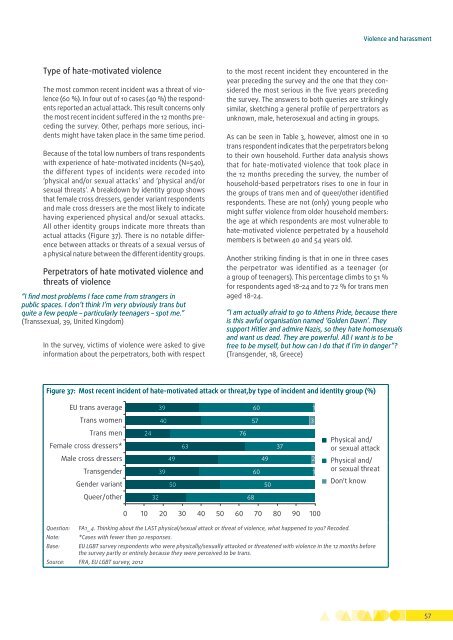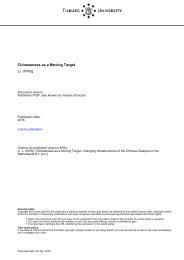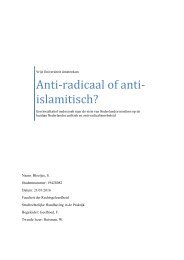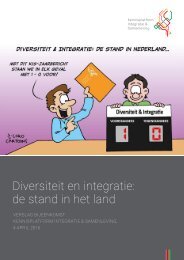fra-2014-being-trans-eu-comparative_en
fra-2014-being-trans-eu-comparative_en
fra-2014-being-trans-eu-comparative_en
Create successful ePaper yourself
Turn your PDF publications into a flip-book with our unique Google optimized e-Paper software.
Viol<strong>en</strong>ce and harassm<strong>en</strong>tType of hate‐motivated viol<strong>en</strong>ceThe most common rec<strong>en</strong>t incid<strong>en</strong>t was a threat of viol<strong>en</strong>ce(60 %). In four out of 10 cases (40 %) the respond<strong>en</strong>tsreported an actual attack. This result concerns onlythe most rec<strong>en</strong>t incid<strong>en</strong>t suffered in the 12 months precedingthe survey. Other, perhaps more serious, incid<strong>en</strong>tsmight have tak<strong>en</strong> place in the same time period.Because of the total low numbers of <strong>trans</strong> respond<strong>en</strong>tswith experi<strong>en</strong>ce of hate‐motivated incid<strong>en</strong>ts (N=540),the differ<strong>en</strong>t types of incid<strong>en</strong>ts were recoded into‘physical and/or sexual attacks’ and ‘physical and/orsexual threats’. A breakdown by id<strong>en</strong>tity group showsthat female cross dressers, g<strong>en</strong>der variant respond<strong>en</strong>tsand male cross dressers are the most likely to indicatehaving experi<strong>en</strong>ced physical and/or sexual attacks.All other id<strong>en</strong>tity groups indicate more threats thanactual attacks (Figure 37). There is no notable differ<strong>en</strong>cebetwe<strong>en</strong> attacks or threats of a sexual versus ofa physical nature betwe<strong>en</strong> the differ<strong>en</strong>t id<strong>en</strong>tity groups.Perpetrators of hate motivated viol<strong>en</strong>ce andthreats of viol<strong>en</strong>ce“I find most problems I face come from strangers inpublic spaces. I don’t think I’m very obviously <strong>trans</strong> butquite a few people – particularly te<strong>en</strong>agers – spot me.”(Transsexual, 39, United Kingdom)In the survey, victims of viol<strong>en</strong>ce were asked to giveinformation about the perpetrators, both with respectto the most rec<strong>en</strong>t incid<strong>en</strong>t they <strong>en</strong>countered in theyear preceding the survey and the one that they consideredthe most serious in the five years precedingthe survey. The answers to both queries are strikinglysimilar, sketching a g<strong>en</strong>eral profile of perpertrators asunknown, male, heterosexual and acting in groups.As can be se<strong>en</strong> in Table 3, however, almost one in 10<strong>trans</strong> respond<strong>en</strong>t indicates that the perpetrators belongto their own household. Further data analysis showsthat for hate‐motivated viol<strong>en</strong>ce that took place inthe 12 months preceding the survey, the number ofhousehold‐based perpetrators rises to one in four inthe groups of <strong>trans</strong> m<strong>en</strong> and of queer/other id<strong>en</strong>tifiedrespond<strong>en</strong>ts. These are not (only) young people whomight suffer viol<strong>en</strong>ce from older household members:the age at which respond<strong>en</strong>ts are most vulnerable tohate‐motivated viol<strong>en</strong>ce perpetrated by a householdmembers is betwe<strong>en</strong> 40 and 54 years old.Another striking finding is that in one in three casesthe perpetrator was id<strong>en</strong>tified as a te<strong>en</strong>ager (ora group of te<strong>en</strong>agers). This perc<strong>en</strong>tage climbs to 51 %for respond<strong>en</strong>ts aged 18–24 and to 72 % for <strong>trans</strong> m<strong>en</strong>aged 18–24.“I am actually a<strong>fra</strong>id to go to Ath<strong>en</strong>s Pride, because thereis this awful organisation named ‘Gold<strong>en</strong> Dawn’. Theysupport Hitler and admire Nazis, so they hate homosexualsand want us dead. They are powerful. All I want is to befree to be myself, but how can I do that if I’m in danger”?(Transg<strong>en</strong>der, 18, Greece)Figure 37: Most rec<strong>en</strong>t incid<strong>en</strong>t of hate‐motivated attack or threat,by type of incid<strong>en</strong>t and id<strong>en</strong>tity group (%)EU <strong>trans</strong> averageTrans wom<strong>en</strong>Trans m<strong>en</strong>Female cross dressers*Male cross dressersTransg<strong>en</strong>derG<strong>en</strong>der variantQueer/other39 60 140 57 324 7663 3749 49 239 60 150 5032 680 10 20 30 40 50 60 70 80 90 100Physical and/or sexual attackPhysical and/or sexual threatDon't knowQuestion:Note:Base:FA1_4. Thinking about the LAST physical/sexual attack or threat of viol<strong>en</strong>ce, what happ<strong>en</strong>ed to you? Recoded.*Cases with fewer than 30 responses.EU LGBT survey respond<strong>en</strong>ts who were physically/sexually attacked or threat<strong>en</strong>ed with viol<strong>en</strong>ce in the 12 months beforethe survey partly or <strong>en</strong>tirely because they were perceived to be <strong>trans</strong>.Source: FRA, EU LGBT survey, 201257









